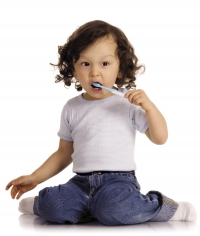 One of the most common questions people ask me is: “At what age should my child see the dentist?”
One of the most common questions people ask me is: “At what age should my child see the dentist?”
A traditional recommendation has been about four years of age. This is the age that we find most children are able to comfortably participate in the normal exam and cleaning. However, several years ago, the Centers for Disease Control and Prevention released a report indicating that 2- to 5-year-olds are the only age group in the United States where the incidence of decay is on the rise. Furthermore, data shows that children seen by age 1 have significantly less dental disease throughout childhood than their peers who are first seen later in life. So the concept of when your child should see the dentist has changed.
This information has led organizations like the American Dental Association (ADA) and Wisconsin Dental Association (WDA) to encourage parents to bring children in for their first visits sooner. Children are now being seen as early as age 1 (or within 6 months of eruption of their first tooth). The visit is meant to serve as an early screening for decay, but also to educate parents and caregivers on the importance of baby teeth.
This has been the focus of the recent “Baby Teeth Matter” ad campaign of the WDA. This campaign is designed to counter the claim that is sometimes made that baby teeth are not important because they just fall out anyway. According to the WDA, baby teeth are important because they:
- Foster good nutrition through proper chewing.
- Aid in speech development.
- Build self-esteem by providing a beautiful smile.
- Enable a child to pay attention and learn in school without the distraction of dental pain.
- Save space in the jaw that is needed for proper development of adult (permanent) teeth.
Clearly, healthy baby teeth should be preserved by preventing early childhood caries.
By providing screenings and education prior to the key 2- to 5-year-old age group, we are making greater efforts to do just that. Aside from the dental office visits, the WDA also recommends the following tips for preventing cavities in baby teeth:
- Mothers and pregnant women should make sure their own mouths are healthy by getting a professional dental exam and necessary care, and by practicing good daily oral hygiene (brush, floss, healthy diet). This reduces transmission of cavity germs from mothers to infants.
- Use breast milk, formula or water in baby’s bottle; never put juice, soda or other sweetened drinks in a baby bottle. Do not put an infant or toddler to bed with a bottle unless it contains only water. Wait until 12 months to give juice and then limit consumption to meal and snack times.
- The American Academy of Pediatric Dentistry (AAPD) encourages parents to have children drink from a cup by their first birthday.
- If a child uses a pacifier, do not dip it in anything sweet like sugar or honey. If it falls on the ground, do not “clean” it in your own mouth as this can transmit cavity-causing germs to the child. Clean with hot water and soap and rinse thoroughly before returning to baby’s mouth.
- Provide healthy snacks, such as meat, peanut butter, milk, yogurt, cheese, fruits and vegetables. Limit sweets in quantity, portion size and frequency.
- Before baby teeth appear, gently wipe gums and inside of the mouth every day, especially after feedings and before bed, with a clean, warm cloth.
- Beginning with the appearance of the first tooth, brush baby teeth twice a day with a soft, age-appropriate sized toothbrush and “smear” of fluoridated toothpaste according to the AAPD. For 2- to 5-year-olds, use a “pea size” amount of toothpaste and perform or assist your child’s tooth brushing.
As with anything, the earlier good habits are established, the better the chances that a child can enjoy good health for the rest of their lives.


